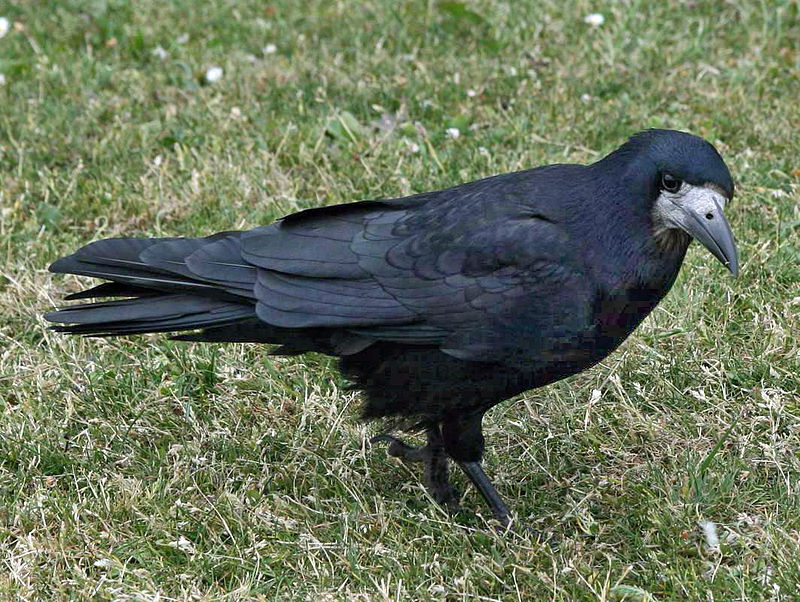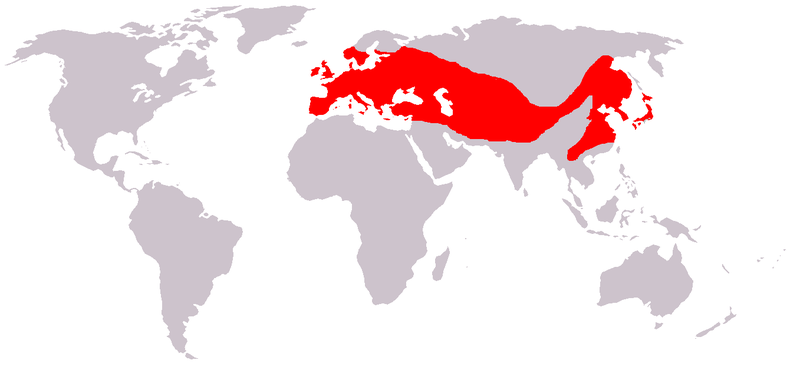Rook
Rook (Corvus frugilegus frugilegus)
Rook
Corvus frugilegus, da. Råge
The Rook (Corvus frugilegus) is a member of the Corvidae family in the passerine order of birds. Named by Carl Linnaeus in 1758, the species name frugilegus is Latin for "food-gathering".
This species is similar in size (45-47 cm in length) to or slightly smaller than the Carrion Crow with black feathers often showing a blue or bluish-purple sheen in bright sunlight. The feathers on the head, neck and shoulders are particularly dense and silky. The legs and feet are generally black and the bill grey-black.
Rooks are distinguished from similar members of the crow family by the bare grey-white skin around the base of the adult's bill in front of the eyes. The feathering around the legs also looks shaggier and laxer than the congeneric Carrion Crow. The juvenile is superficially more similar to the Crow because it lacks the bare patch at the base of the bill, but it has a thinner bill and loses the facial feathers after about six months. Collective nouns for rooks include building, parliament, clamour and storytelling. Their nesting patterns gave rise to the term rookery.
Distribution and habitat
Though resident in Great Britain, Ireland and much of north and central Europe, vagrant to Iceland and northern Scandinavia, it also occurs as an eastern race in Asia where it differs in being very slightly smaller and more efficient on average, and having a somewhat more fully feathered face. In the north of its range the species has a tendency to move south during autumn though more southern populations are apt to range sporadically also. The species has been introduced to New Zealand, with several hundred birds being released there from 1862 to 1874, though today their range is very localised. There the species is an agricultural pest and it is being eradicated.
Diet
Food is predominantly earthworms and insect larvae, which the bird finds by probing the ground with its strong bill. It also eats cultivated cereal grain, smaller amounts of fruit, small mammals, acorns, small birds, their eggs and young and carrion. In urban sites, human food scraps are taken from rubbish dumps and streets, usually in the early hours when it is relatively quiet. It has also been seen along the seashore, feeding on insects, crustaceans and suitable food flotsam.
Nesting
The distribution of rook colony sizes in Normandy. Most colonies are small, a few are large (smoothed). Nesting in a rookery is always colonial, usually in the very tops of the trees. Branches and twigs are broken off trees (very rarely picked up off the ground), though as many are likely to be stolen from nearby nests as are collected from trees. Eggs are usually 3-5 in number, can appear by the end of February or early March and are incubated for 16-18 days. Both adults feed the young, which are fledged by the 32nd or 33rd day.
In autumn, the young birds of the summer collect into large flocks together with unpaired birds of previous seasons, often in company with Jackdaws. It is during the autumn that spectacular aerial displays can be seen by adult birds that seem to delight in the autumn gales.
Voice
The call is usually described as "kaah" - it is similar to that of the Carrion Crow, but usually rather flatter in tone. It is given both in flight and while perched, when the bird fans its tail and bows on each caw. Calls in flight are usually given singly, in contrast to the Carrion Crow's which are in groups of three or four. Solitary birds often "sing" apparently to themselves, uttering strange clicks, wheezes and almost human-like notes.
Intelligence
In captivity, when confronted with problems, rooks have been documented as one of several species of birds capable of using tools to obtain a goal. Rooks learned that if they push a stone off a ledge into a tube, they will get food. The rooks then discovered they could go get a stone and carry it to the tube if no stone was there already. They also used sticks, wire and figured out how to bend a wire into a hook to reach an item. Rooks are as clever at making and using simple tools with their beaks as chimpanzees are with their hands.
In an experiment, a rook was placed near a tube of water, with a worm floating on top of the water, and some rocks next to the tube. The water level was too low for the rook to reach the worm. The rook placed rocks into the tube until the water level was high enough for the rook to reach the worm.
Sociability
"A lady wrote to the correspondence columns of a newspaper to recount an interesting experience. The trees in her garden provided the nesting site for a large colony of rooks. One day she observed a pair of the birds starting to build their nest at some distance from the main colony, but this independence could not be tolerated by the rest of the colony (rooks are strongly social and gregarious) and they demolished this attempt at a break- away. The couple did not give up, but persisted in a second attempt; this suffered a like fate, as did their third attempt at diversity. The day after their third effort had failed, the lady was awoken by unusual sounds from the birds. She got up and went to the window, from where she saw the rooks ranged in a circle on the grass, and in the center of the circle was an isolated pair. After a period of agitated excitement the mob attacked the errant pair and killed them."
ref.:
Rook (Wikipedia)
Rook (Corvus frugilegus) (Google)
Rook (Corvus frugilegus) (Google Pics)
Corvus frugilegus (YouTube)
Rook (Corvus frugilegus)
+++++++++++++++++++++++++++++++++++
Have you got any comment, please mail:
Sincerely
Kurt Starlit
aka CykelKurt
Crows of The World


